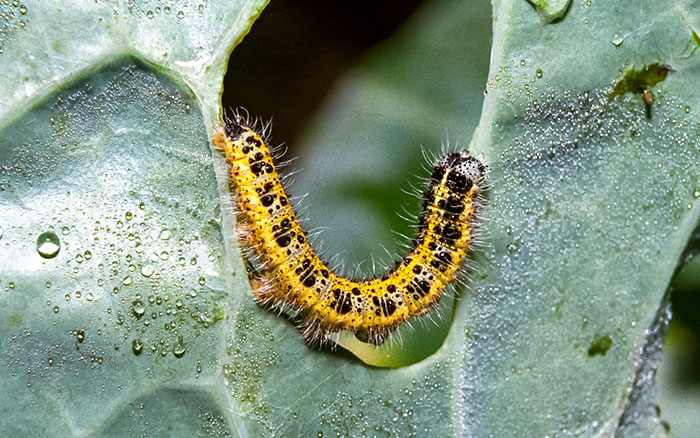Although there are more than 2,600 different types of caterpillars, only a handful of them are classified as pests. Therefore, it’s vitally important to be sure you have a pest before intervening. Several wildlife organisations, such as Wildlifesight, have charts to help you identify caterpillars online.
What are caterpillars
A caterpillar is defined as a small, long animal with many legs. They feed on the leaves of plants and develop into a butterfly or moth.
Certain caterpillars cause damage to vegetable and fruit crops as well as some ornamental plants, such as box.
How to spot caterpillars
The majority of caterpillar damage on vegetable crops occurs during the spring and summer months. They feast on all edible brassicas, such as broccoli, cabbage and sprouts but other crops can be affected too. Such as horseradish, swede and turnips, caused by cabbage caterpillars. Holes can be seen in the outer leaves and sometimes in the inner parts of vegetables.
Box tree caterpillar is a serious pest on box plants and can rapidly completely defoliate it. The most obvious symptom is thick sections of silvery grey webbing as well as patches of dieback on the plant.



How to control caterpillars
Try prevention on vegetable plants by covering newly planted plants with horticultural fleece or fine netting to stop butterflies and moths from laying eggs on the plants.
Check your veg plants regularly from spring onwards, picking off any pale yellow or white spherical eggs seen on leaves. Because early detection makes it much easier to control damage.
If the infestation is light, so, therefore, try doing nothing and provide nest boxes and food. These attract hedgehogs, birds and social wasps into the garden as they will all feed on them!
There is a biological control of nematodes available to buy from garden centres and online. As well as a product marketed as a repellent against cabbage caterpillars, called Grazers G3.
For box tree caterpillars again start to check plants from early spring onwards. Remove caterpillars by hand and/or apply a fruit and vegetable nematode biological control.
Putting a hose pipe on a narrow setting, turning it on full, directed at the webbing. This can help in that it exposes the pupae hiding under the webbing to enable birds to predate upon them.


Need advice?
If you need specialist advice, I recommend you get in touch with your local garden centre, plant nursery or contact the advisory service of the Royal Horticultural Society.

Always on the look out for a reputable nurseryman and business because I am a passionate gardener.